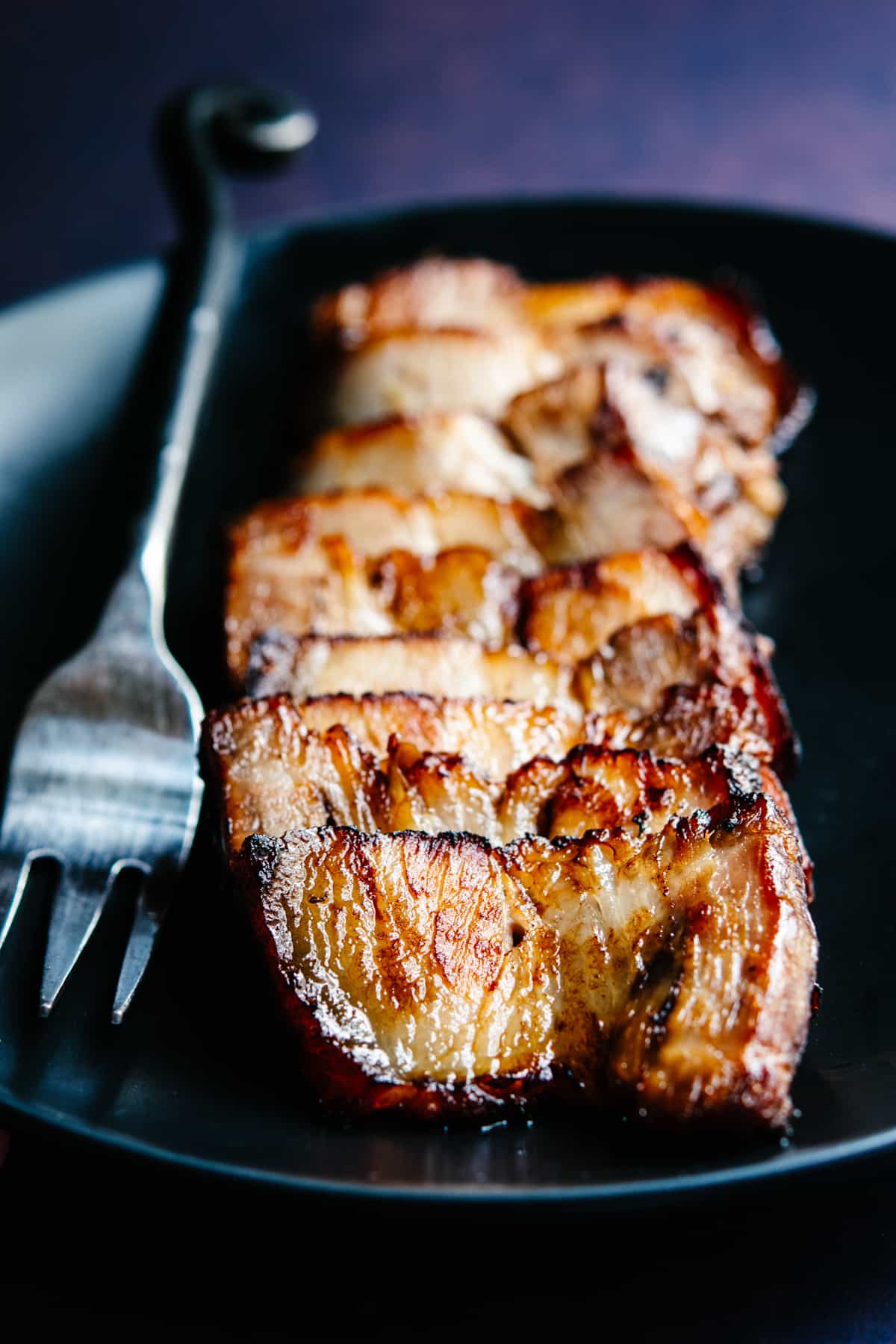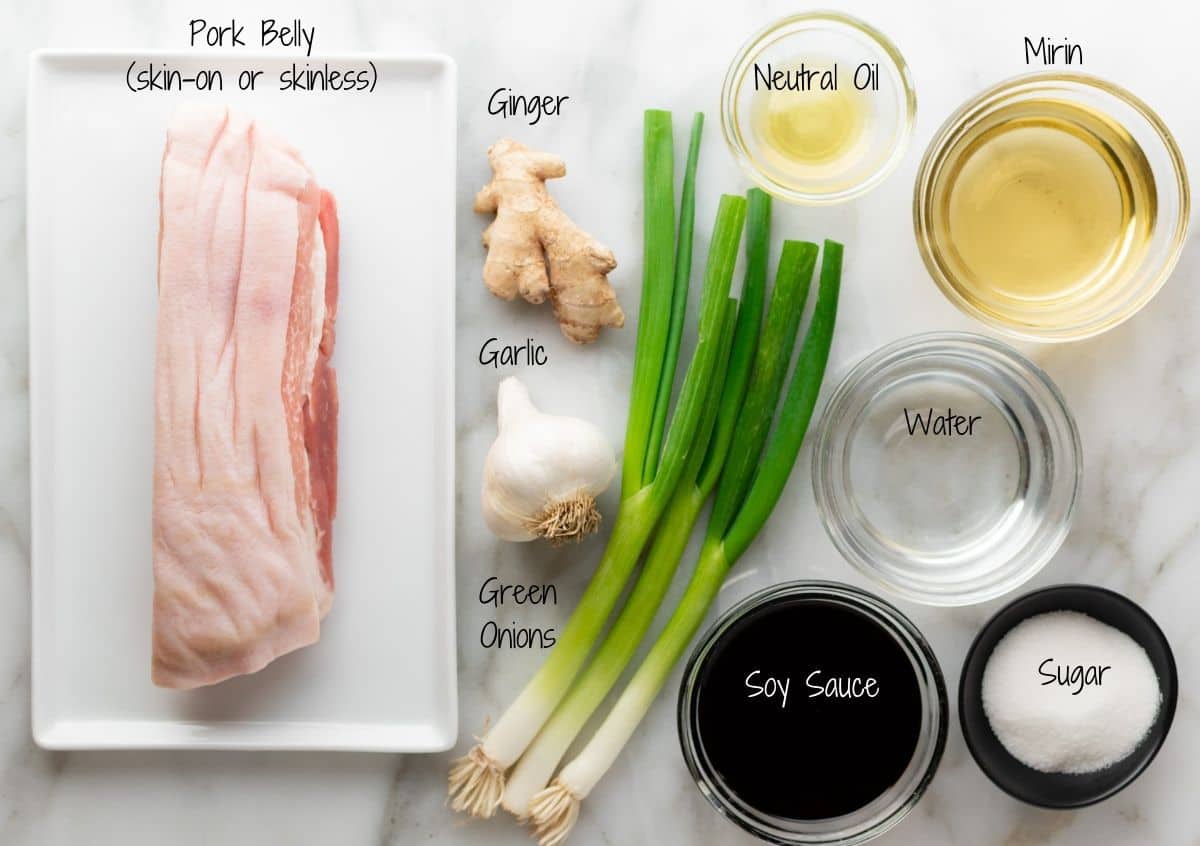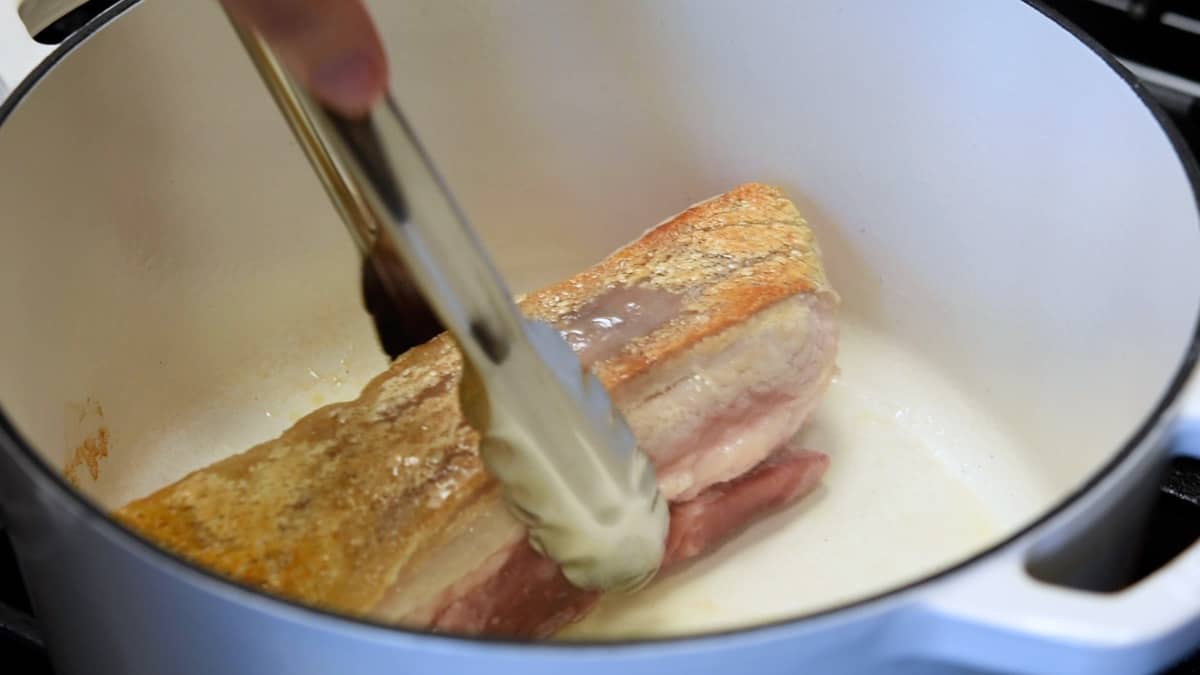This post may contain affiliate links. Please read our disclosure policy.
Chashu Pork is meltingly tender pork belly that’s been slow-braised in an intense blend of soy sauce, sweet mirin, ginger, garlic and green onions. It’s an essential topping at any ramen house and, with this much simplified method, it’s easy to make at home.

When you’ve seen other chashu pork recipes, the meat may have been tightly rolled with twine into a spiral. Though very pretty, it requires large cuts of pork belly (2 pounds or more) and a bit of time and skill to roll and tie it properly. Here I’m using a smaller cut (just 1 pound) with a shorter cooking time and no rolling required, all of the flavor and none of the fuss.
Table of Contents
Ingredients You Need to Make Chashu Pork

- Pork Belly: skin-on or skinless thick cut of even thickness
- Soy Sauce: or tamari for a gluten free version
- Mirin: You can also use sake, but you’ll want to add an extra tablespoon of sugar.
- Sugar: granulated white sugar
- Oil: neutral flavored, high heat vegetable oil such as avocado oil
- Garlic: Look for a plump, firm head of garlic with smooth skin and large cloves.
- Green Onions: or spring onions when they’re in season
- Ginger: fresh ginger root, powdered ginger isn’t a good substitute here
If you’ve had Tonkotsu (meaning “pork bones”) ramen before, with it’s rich pork bone broth, you already know chashu pork, the tender slices of pork belly served on top. It’s traditionally made by rolling the meat into a log and braising it ‘low and slow’ for many hours, then chilling overnight. The next day it’s thinly sliced and warmed before serving.
What is chashu?
Chashu, the Japanese name for this dish, actually comes from the Cantonese dish “char-siu,” meaning “fork roasted.” Though the names and some of the flavors are similar, the dishes are prepared differently. Cantonese char-siu is roasted after marinating in a sweet sauce with five spice powder and often red food dye. By contrast, Japanese chashu is braised low and slow in a sweet and salty mixture, often with aromatics like ginger and garlic, but without five spice powder or food dye.

Not Just for Ramen
Don’t limit the use of your chashu to just soup. Though this unctuous, melt-in-your-mouth meat is the ideal topping for Pork Belly Ramen, weeknight easy Homemade Ramen or with Miso Ramen Broth or Shoyu Ramen Broth (with Homemade Ramen Noodles!), it’s also wonderful served over udon, soba or rice noodles, over rice (chashu don) with braised vegetables and Soy Sauce Eggs, eaten alone as you would Korean Pork Belly, or as a chashu pork sandwiches on brioche slider buns, i.e., Pork Belly Sliders.
And once you’ve chilled your chashu overnight, don’t throw away the braising liquid! Just skim off the fat and reserve the liquid to kick up the flavor in all kinds of Asian soups, steamed vegetables, noodle and stir-fry dishes, and rice bowls. It freezes well too if you don’t want to use it right away.
Skinless vs. Skin-On
Either cut works well with this recipe, but note that skinless pork belly will render more fat as it braises and you’ll end up with less fatty slices. With skin-on pork belly, the meat may curl as it braises (as in this Braised Pork Belly recipe). If it does, cook 30 minutes per side during the final hour of braising instead of flipping it completely.
Storage Tips
Enjoy your chashu pork within 3 or 4 days or freeze for up to 3 months.
How to Make Chashu Pork
Step 1: Combine braising liquid ingredients: water, soy sauce, mirin and sugar; stir until sugar dissolves.

Step 2: Sear pork belly on all sides in hot oil in an oven safe pot. Remove from heat; add aromatics (ginger, garlic and green onions) and pour braising liquid over. Cover and cook, fat / skin-side down in an oven preheated to 250˚F for 1 1/2 hours. Flip meat and cook 1 hour more.





Step 3: Transfer meat to a smaller container and pour braising liquid over. Once it cools, cover and refrigerate overnight. The next day, transfer the meat to a cutting board and thinly slice. Pan fry over medium heat until lightly golden and serve as desired.






Chashu Pork

Video
Equipment
- Dutch oven or other heavy, oven-safe pot
Ingredients
- 1/2 cup water
- 1/2 cup soy sauce
- 1/2 cup mirin
- 2 tablespoons granulated sugar
- 2 teaspoons vegetable oil such as avocado oil or other high heat, neutral flavored oil
- 1 pound pork belly skin-on or skinless (see recipe note #1)
- 2 large garlic cloves crushed and peeled
- 3 green onions cut lengthwise into 2-inch pieces
- 2 inches fresh ginger root thinly sliced (peeled if desired)
Instructions
- Preheat oven to 250˚F.
- In a medium bowl, whisk together water, soy sauce, mirin and sugar until sugar dissolves. Set aside.
- Heat oil over medium-high heat in a Dutch oven or other heavy, oven-safe pot until shimmering, but not quite smoking. Add pork belly and sear on all sides, about 2 minutes per side. Remove from heat.
- Flip pork belly if needed so that the fat / skin side is down. Pour soy sauce mixture over (the liquid should come about half way up the side – add a bit more water if it doesn't) and add garlic, green onions and ginger to liquid. Cover pot and place in the center of preheated oven. Cook for 1 1/2 hours; then flip pork belly to meat side and cook 1 hour more (see recipe note #2). Let pork belly cool in liquid, then transfer to a smaller container, pouring cooking liquid over the top; cover and refrigerate overnight.
- The next day, scrape the fat off of the braising liquid and transfer pork to a cutting board. Strain solids from braising liquid and save for another use. (recipe note #3) With a sharp knife, cut into thin slices and pan fry until lightly golden in a non-stick skillet over medium heat. Serve as desired. (recipe note #4)
Notes
- Use this recipe for skin-on or skinless pork belly. The main difference you’ll notice is how much more fat renders from the skinless cut. Look for a thick cut of pork belly with even thickness. Very thin cuts will cook faster and you’ll need to reduce the overall cook time. I recommend checking it every 15 minutes or so once you’ve flipped your pork belly.
- With skin-on pork belly, the belly may curl somewhat so that it doesn’t lie flat when you flip it. If this happens, cook skin side down for 1 1/2 hours, then, instead of flipping completely, cook on each side for 30 minutes each. Skinless pork belly is less likely to curl and you can just flip it completely, following the recipe instructions. Either way, you’ll need 2 1/2 hours total cook time unless your pork belly is thin (see recipe note above).
- Use the braising liquid to drizzle over any kind of meat or seafood, to flavor stir-fries or ramen broths.
- I recommend enjoying it in my Pork Belly Ramen with Homemade Ramen Noodles!
Nutrition
Nutrition information is automatically calculated, so should only be used as an approximation.














Is it required to refrigerate overnight or can I skip that step and slice it and fry it right away?
Hi Aeriel! I don’t recommend skipping refrigeration – the pork will firm up (making it much easier to slice) and soak in lots of great flavor from the cooking liquid.
Can I use different cut of pork instead of pork belly for this recipe? My family doesn’t like the fat of pork belly.
Hi Vonny! The fattiness of pork belly is key to the flavor of Chashu – I think a lean cut might end up too dry.